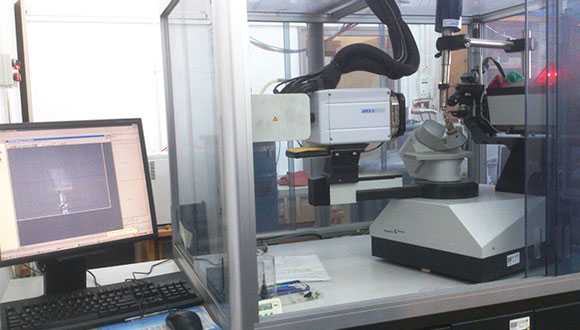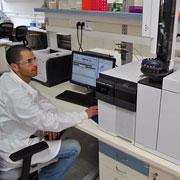Crystallography Lab
The Chemical Crystallography facility at TAU offers a complete service of structure determination of crystalline solids by X-ray diffraction techniques at wide temperature ranges. It allows the elucidation of 3D molecular and crystal structures of a wide variety of organic, metal-organic and inorganic compounds available in single crystal form an at atomic level with high accuracy unmatched by other techniques.
Equipment:
Our laboratory houses two single-crystal diffractometers and a desktop powder diffractometer:
-
The Nonius Kappa CCD automated diffractometer with Bruker Apex II detector is equipped with a 2 kW Mo sealed tube.

-
The Bruker Kappa ApexDuo single crystal diffractometer, two-wavelength system with molybdenum and copper micro-focus sources. In addition to routine crystal structure determinations, this system can be used for studies of high-resolution electron-density with Mo radiation and can exploit all the advantages of a high-brightness Cu source for absolute structure determination and diffraction experiments on ever small weakly diffracting crystals.

-
Both instruments are equipped with Cryostream systems (from Oxford Instruments) for cooling the crystals to liquid-nitrogen temperatures during data collection. This offers several significant benefits (reduction of thermal motion, higher data resolution, and data collection for relatively air/moisture/temperature sensitive crystals). The experiment's temperature can be tuned between 90 and 370 K for special cases (e.g. studies of phase transitions).

-
The Rigaku Miniflex table-top powder diffractometer is mostly used for generating fingerprint diffraction patterns from powdered solids, as well as for undergraduate instruction.
-
A wide variety of software used in X-ray crystallography for structure determination, refinement and presentation, as well as direct access to the Cambridge Structural Database (CSD) for organic and organometallic compounds, are available in the laboratory.
-
The selection of a suitable crystal for single-crystal experiments will normally be performed under oil using an optical microscope in order to find the most suitable (single) crystal for the investigation. For crystals that are relatively air/moisture/temperature sensitive, we can use the X-Temp2 apparatus generating a cold N2 stream on the analyzed material placed on the microscope slide in order to prevent crystal decomposition.
Services
The following small molecule crystallography services are offered to members of the TAU School of Chemistry, other TAU researchers, academic Institutions outside TAU and industrial clients:
-
Consulting on crystallization of diffraction quality crystals
-
Screening single crystals for suitability for data collection
-
Data base searching (CCSD)
-
Mounting of crystals, including air, moisture and temperature sensitive samples
-
Determination of crystal systems, space groups and unit cell parameters
-
Collecting X-ray intensity data from the crystals (if they are suitable) at room or low temperatures - We will collect and process X-ray data and perform a full crystal structure analysis.
-
Detailed reports of the used experimental conditions, with tables of atomic coordinates, thermal displacement parameters and diverse geometric characterizations of the structure. Provision of Crystal Information Files (CIF).
Sample requirements for detailed crystal structure determination
Single crystals of at least 0.1 mm in all three dimensions, ideally larger than this but no greater than 0.5 mm. Crystals larger than 0.5 mm will need to be cut down to size.
How to submit crystals
-
Please contact Dr. Sophia Lipstman first so that we can discuss the services needed. You can see our price list.
-
Download the submission form and fill it out. Please fill out all paragraphs including budget number, signature of authorized researcher, all solvents and empirical molecular formula. Characterize your sample as completely as possible before submission. You will be very embarrassed if your new crystals turn out to be NaCl, starting material, or some other well known substance.
-
Bring your sample to us. Vials must be labeled using a sticker or hang-tag (not only marker directly on glass). Labels must include your name, your advisor's name, and the exact sample ID used in the submission form.
-
If you have any special requirements for storage please contact us to discuss these, and where possible, we will be happy to arrange these facilities.
Software
Mercury - https://www.ccdc.cam.ac.uk/Solutions/FreeSoftware/Pages/FreeMercury.aspx
EnCIFer - https://www.ccdc.cam.ac.uk/Solutions/FreeSoftware/Pages/EnCIFer.aspx
Permanent Staff:
Dr. Sophia Lipstman, Crystallographer and Facilities Director
Location: 420 Ornstein building
Office: 972-3-6406433
Mobile: 972-54-6357057
Email: lipstman@post.tau.ac.il
Contact:
Location: 416-420 Ornstein building
Phone at Office: 972-3-6406433
Mobile: 972-54-6357057
Email: lipstman@post.tau.ac.il




